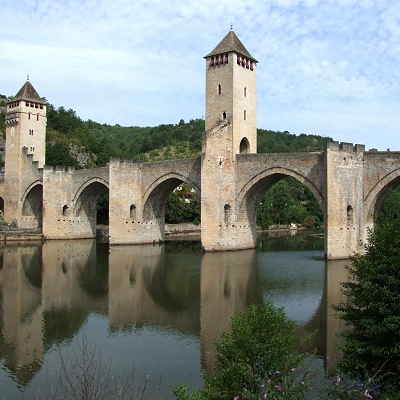
Like us on Facebook
PLACE NAMES


 
|
|
Cahors
|

|
|
Cahors is the capital of the Lot department in south-western France.
Its site is dramatic, being contained on three sides within a U-shaped bend in the River Lot known as the presqu'île ("peninsula"). Today Cahors is perhaps best known as the centre of the famous AOC 'black' wine known since the Middle Ages and exported via Bordeaux, long before that region had developed its own viniculture industry.
Main sights:-
- The Valentré Bridge, the symbol of the town. Building began in 1308 and was completed in 1378. The legend associated with this bridge is one of the most fully realized of all Devil's Bridge legends, with a carefully developed plot, complex characters, and a surprising dénouement. When the bridge was restored in 1879, the architect Paul Gout made reference to this by placing a small sculpture of the devil at the summit of one of the towers.
- Cathédrale Saint-Étienne, a national monument.
- Saint-Barthélémy Church (14th century).
- Maison Henri IV or Hôtel de Roaldès (15th century).
- Daurade quarter.
- Maison Hérétié (14th-16th centuries)
- Maison Dolive (17th century)
- Maison du Bourreau (13th century)
- The barbican that once defended the Barre Gate.
- Tour des pendus.
- Palais Duèze.
- Tower of Pope John XXII.
- Collège Pélegry.
- Cloister
- Arc de Diane, a relic of ancient Roman baths.
- Roman Amphitheatre - remains of an oval amphitheatre were revealed when the underground car park was excavated at the Place Gambetta, just west of, and partially beneath, Boulevard Gambetta in the city centre. The stone walls can be seen in the car park first level, below the statue of Leon Gambetta, and opened to the public in April 2009.
 Feel free to Email me any additions or corrections Feel free to Email me any additions or corrections
LINKS AVAILABLE TO YOUR SITE
| | |





